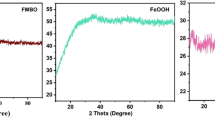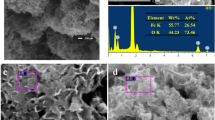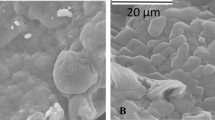Abstract
Arsenic contamination of drinking water is a serious water quality problem in many parts of the world. In this study, a low-cost manganese oxide ore from Vietnam (Vietnamese manganese oxide (VMO)) was firstly evaluated for its performance in arsenate (As(V)) removal from water. This material contains both Mn (25.6%) and Fe (16.1%) mainly in the form of cryptomelane and goethite minerals. At the initial As(V) concentration of 0.5 mg/L, the adsorption capacity of original VMO determined using the Langmuir model was 0.11 mg/g. The modified VMOs produced by coating VMO with iron oxide (Fea-VMO) and zirconium oxide (Zra-VMO) at 110 °C and 550 °C achieved the highest As(V) adsorption capacity when compared to three other methods of VMO modifications. Langmuir maximum adsorption capacities of Fea-VMO and Zra-VMO at pH 7.0 were 2.19 mg/g and 1.94 mg/g, respectively, nearly twenty times higher than that of the original VMO. Batch equilibrium adsorption data fitted well to the Langmuir, Freundlich, and Temkin models and batch kinetics adsorption data to pseudo-first order, pseudo-second order, and Elovich models. The increase of pH progressively from 3 to 10 reduced As(V) adsorption with a maximum reduction of 50–60% at pH 10 for both original and modified VMOs. The co-existing oxyanions considerably weakened the As(V) removal efficiency because they competed with As(V) anions. The competition order was PO43− > SiO32− > CO32− > SO42−. The characteristics of the original and modified VMOs evaluated using SEM, FTIR, XRD, XRF, surface area, and zeta potential explained the As(V) adsorption behaviour.










Similar content being viewed by others
References
Adeogun AI, Babu RB (2015) One-step synthesized calcium phosphate-based material for the removal of alizarin S dye from aqueous solutions: isothermal, kinetics, and thermodynamics studies. Appl Nanosci:1–13
Ahmed MF (2001) An overview of arsenic removal technologies in Bangladesh and India. Proceedings of BUET-UNU international workshop on technologies for arsenic removal from drinking water, Dhaka, Bangladesh, pp 5–7
Altundoğan HS, Altundoğan S, Tümen F, Bildik M (2002) Arsenic adsorption from aqueous solutions by activated red mud. Waste Manag 22:357–363
Amini M, Abbaspour KC, Berg M, Winkel L, Hug SJ, Hoehn E, Yang H, Johnson (2008) Statistical modeling of global geogenic arsenic contamination in groundwater. Environ Sci Technol 42:3669–3675
Asere TG, Stevens CV, Du Laing G (2019) Use of (modified) natural adsorbents for arsenic remediation: a review. Sci Total Environ 676:706–720
Berg M, Stengel C, Trang PTK, Viet PH, Sampson ML, Leng M, Samreth S, Fredericks D (2007) Magnitude of arsenic pollution in the Mekong and Red River Deltas—Cambodia and Vietnam. Sci Total Environ 372:413–425
Berg M, Tran HC, Nguyen TC, Pham HV, Schertenleib R, Giger W (2001) Arsenic contamination of groundwater and drinking water in Vietnam: a human health threat. Environ Sci Technol 35:2621–2626
Buschmann J, Berg M, Stengel C, Sampson ML (2007) Arsenic and manganese contamination of drinking water resources in Cambodia: coincidence of risk areas with low relief topography. Environ Sci Technol 41:2146–2152
Camacho LM, Parra RR, Deng S (2011) Arsenic removal from groundwater by MnO2-modified natural clinoptilolite zeolite: effects of pH and initial feed concentration. J Hazard Mater 189:286–293
Chakraborti D, Rahman MM, Paul K, Chowdhury UK, Sengupta MK, Lodh D, Chanda CR, Saha KC, Mukherjee SC (2002) Arsenic calamity in the Indian subcontinent: what lessons have been learned? Talanta 58:3–22
Chakravarty S, Dureja V, Bhattacharyya G, Maity S, Bhattacharjee S (2002) Removal of arsenic from groundwater using low cost ferruginous manganese ore. Water Res 36:625–632
Chiban M, Zerbet M, Carja G, Sinan F (2012) Application of low-cost adsorbents for arsenic removal: a review. Journal of Environmental Chemistry and Ecotoxicology 4:91–102
Ciardelli MC, Xu H, Sahai N (2008) Role of Fe (II), phosphate, silicate, sulfate, and carbonate in arsenic uptake by coprecipitation in synthetic and natural groundwater. Water Res 42:615–624
Dada A, Olalekan A, Olatunya A, Dada O (2012) Langmuir, Freundlich, Temkin and Dubinin–Radushkevich isotherms studies of equilibrium sorption of Zn2+ unto phosphoric acid modified rice husk. IOSR J Appl Chem 3:38–45
Delva L, Verberckmoes A, Cardon L, Ragaert K (2013) The use of rubber as a compatibilizer for injection moulding of recycled post-consumer mixed polyolefines. 2nd International Conference WASTES: Solutions, Treatments and Opportunities. CVR, Braga, Portugal
Erhayem M, Al-Tohami F, Mohamed R, Ahmida K (2015) Isotherm, kinetic and thermodynamic studies for the sorption of mercury (II) onto activated carbon from Rosmarinus officinalis leaves. American J Ana Chem 6:1
Firdaous L, Fertin B, Khelissa O, Dhainaut M, Nedjar N, Chataigné G, Ouhoud L, Lutin F, Dhulster P (2017) Adsorptive removal of polyphenols from an alfalfa white proteins concentrate: adsorbent screening, adsorption kinetics and equilibrium study. Sep Purif Technol 178:29–39
Gu Z, Fang J, Deng B (2005) Preparation and evaluation of GAC-based iron-containing adsorbents for arsenic removal. Environ Sci Technol 39:3833–3843
Hang C, Li Q, Gao S, Shang JK (2011) As (III) and As (V) adsorption by hydrous zirconium oxide nanoparticles synthesized by a hydrothermal process followed with heat treatment. Ind Eng Chem Res 51:353–361
Järup L (2003) Hazards of heavy metal contamination. Br Med Bull 68:167–182
Jia Y, Xu L, Wang X, Demopoulos GP (2007) Infrared spectroscopic and X-ray diffraction characterization of the nature of adsorbed arsenate on ferrihydrite. Geochim Cosmochim Ac 71:1643–1654
Kabir F, Chowdhury S (2017) Arsenic removal methods for drinking water in the developing countries: technological developments and research needs. Environ Sci Pollut Res 24:24102–24120
Kalaruban M, Loganathan P, Shim W, Kandasamy J, Naidu G, Nguyen TV, Vigneswaran S (2016) Removing nitrate from water using iron-modified Dowex 21K XLT ion exchange resin: batch and fluidised-bed adsorption studies. Sep Purif Technol 158:62–70
Khan TA, Chaudhry SA, Ali I (2013) Thermodynamic and kinetic studies of As (V) removal from water by zirconium oxide-coated marine sand. Environ Sci Pollut Res 20:5425–5440
Loganathan P, Vigneswaran S, Kandasamy J, Bolan NS (2014) Removal and recovery of phosphate from water using sorption. Crit Rev Environ Sci Technol 44:847–907
Maiti A, Basu JK, De S (2010) Development of a treated laterite for arsenic adsorption: effects of treatment parameters. Ind Eng Chem Res 49:4873–4886
Mamindy-Pajany Y, Hurel C, Marmier N, Roméo M (2011) Arsenic (V) adsorption from aqueous solution onto goethite, hematite, magnetite and zero-valent iron: effects of pH, concentration and reversibility. Desalination 281:93–99
Markovski JS, Marković DD, Đokić VR, Mitrić M, Ristić MĐ, Onjia AE, Marinković AD (2014) Arsenate adsorption on waste eggshell modified by goethite, α-MnO2 and goethite/α-MnO2. Chem Eng J 237:430–442
Mohan D, Pittman CU Jr (2007) Arsenic removal from water/wastewater using adsorbents—a critical review. J Hazard Mater 142:1–53
Mondal P, Balomajumder C, Mohanty B (2007) A laboratory study for the treatment of arsenic, iron, and manganese bearing ground water using Fe3+ impregnated activated carbon: effects of shaking time, pH and temperature. J Hazard Mater 144:420–426
Myneni SC, Traina SJ, Waychunas GA, Logan TJ (1998) Vibrational spectroscopy of functional group chemistry and arsenate coordination in ettringite. Geochim Cosmochim Ac 62:3499–3514
Nur T, Johir M, Loganathan P, Nguyen T, Vigneswaran S, Kandasamy J (2014) Phosphate removal from water using an iron oxide impregnated strong base anion exchange resin. J Ind Eng Chem 20:1301–1307
Oladoja N, Helmreich B (2014) Batch defluoridation appraisal of aluminium oxide infused diatomaceous earth. Chem Eng J 258:51–61
Önal Y (2006) Kinetics of adsorption of dyes from aqueous solution using activated carbon prepared from waste apricot. J Hazard Mater 137:1719–1728
Ouvrard S, Simonnot M-O, Sardin M (2002) Reactive behavior of natural manganese oxides toward the adsorption of phosphate and arsenate. Ind Eng Chem Res 41:2785–2791
Petit T, Puskar L (2018) FTIR spectroscopy of nanodiamonds: methods and interpretation. Diam Relat Mater
Pokhrel D, Viraraghavan T (2008) Arsenic removal from an aqueous solution by modified A. niger biomass: batch kinetic and isotherm studies. J Hazard Mater 150:818–825
Polya D, Gault A, Diebe N, Feldman P, Rosenboom J, Gilligan E, Fredericks D, Milton AH, Sampson M, Rowland HAL (2005) Arsenic hazard in shallow Cambodian groundwaters. Mineral Mag 69:807–823
Puttamat S, Pavarajarn V (2016) Adsorption study for removal of Mn (II) ion in aqueous solution by hydrated ferric (III) oxides. Inter J Chem Eng Appl 7:239–243
Qiu H, Lv L, Pan B-c, Q-j Z, W-m Z, Q-x Z (2009) Critical review in adsorption kinetic models. J Zhejiang University-Sci A 10:716–724
Ren Z, Zhang G, Paul Chen J (2011) Adsorptive removal of arsenic from water by an iron-zirconium binary oxide adsorbent. J Colloid Interface Sci 358:230–237
Shahmohammadi-Kalalagh S (2011) Isotherm and kinetic studies on adsorption of Pb, Zn and Cu by kaolinite. Casp J Environ Sci 9:243–255
Smedley PL, Kinniburgh D (2002) A review of the source, behaviour and distribution of arsenic in natural waters. Appl Geochem 17:517–568
Sogaard E (2014) Chemistry of advanced environmental purification processes of water: fundamentals and applications. Elsevier, Amst
Thirunavukkarasu O, Viraraghavan T, Subramanian K (2001) Removal of arsenic in drinking water by iron oxide-coated sand and ferrihydrite-batch studies. Water Qual Res J 36:55–70
Thirunavukkarasu O, Viraraghavan T, Subramanian K (2003) Arsenic removal from drinking water using iron oxide-coated sand. Water Air Soil Pollut 142:95–111
Tomić ZP, Antić-Mladenović SB, Babić BM, Poharc-Logar VA, Đorđević AR, Cupać SB (2011) Modification of smectite structure by sulfuric acid and characteristics of the modified smectite. J Agric Sci 56:25–35
Worch E (2012) Adsorption technology in water treatment: fundamentals, processes, and modeling. Walter de Gruyter
Wu C, Tu J, Liu W, Zhang J, Chu S, Lu G, Lin Z, Dang Z (2017) The double influence mechanism of pH on arsenic removal by nano zero valent iron: electrostatic interactions and the corrosion of Fe 0. Environ Sci: Nano 4:1544–1552
Wu F-C, Tseng R-L, Juang R-S (2009) Characteristics of Elovich equation used for the analysis of adsorption kinetics in dye-chitosan systems. Chem Eng J 150:366–373
Zhang G, Liu H, Liu R, Qu J (2009) Adsorption behavior and mechanism of arsenate at Fe-Mn binary oxide/water interface. J Hazard Mater 168:820–825
Zhou Z, Y-g L, S-b L, H-y L, G-m Z, Tan X-f, Yang C-p, Ding Y, Z-l Y, X-x C (2017) Sorption performance and mechanisms of arsenic(V) removal by magnetic gelatin-modified biochar. Chem Eng J 314:223–223
Funding
The project was funded by the Australian Government Department of Foreign Affairs and Trade’s (DFAT) innovationXchange (iXc).
Author information
Authors and Affiliations
Corresponding author
Additional information
Responsible Editor: Tito Roberto Cadaval Jr
Publisher’s note
Springer Nature remains neutral with regard to jurisdictional claims in published maps and institutional affiliations.
Rights and permissions
About this article
Cite this article
Nguyen, T.T.Q., Loganathan, P., Nguyen, T.V. et al. Removing arsenic from water with an original and modified natural manganese oxide ore: batch kinetic and equilibrium adsorption studies. Environ Sci Pollut Res 27, 5490–5502 (2020). https://doi.org/10.1007/s11356-019-07284-3
Received:
Accepted:
Published:
Issue Date:
DOI: https://doi.org/10.1007/s11356-019-07284-3




